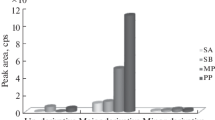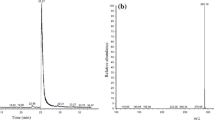Abstract
In this paper, we describe the approach to the characterization of an unusual material seized by the judicial authority, near Brescia City in Northern Italy. Usual analyses such as thin-layer chromatography, gas chromatography (GC)–flame ionization detection, and GC/mass spectrometry (MS) did not show the presence of drugs of abuse, in particular amphetamine-like compounds. The major solid component was identified as cornstarch; then taking into account the strong aromatic scent of the seized material; a preliminary experiment for volatile organic compounds was carried out by headspace (HS)-GC/MS. This analysis tentatively evidenced the presence of 1-phenyl-2-propanone (P2P), an amphetamine precursor. Therefore, we developed and optimized a new analytical method for determination of P2P in seized materials by HS-GC/MS. We also synthesized P2P, with the permission of the Ministry of Health, to have it as reference standard, because of its being illegal and the difficulty in obtaining it. This case had some analogies with the cases referred to as “wet amphetamine” by the judicial authority, in which amphetamines are sold mixed with P2P. The possible use of the material could be the production of tablets made of cornstarch with an aromatic scent similar to that of amphetamines to deceive consumers and to sell them as a drug of abuse.







Similar content being viewed by others
References
Council of Europe (2015) IIX Edition of the European Pharmacopoeia. https://www.edqm.eu/en/european-pharmacopoeia-8th-edition-1563.html. Accessed July 2015
Gambaro V, Arnoldi S, Casagni E, Dell’Acqua L, Farè F, Saligari E, Valoti E (2005) Analytical approach for the identification of impurities, intermediates and precursors of the entactogen synthesis. Boll Chim Farm 144:1–16
Yashiki M, Kojima T, Miyazaki T, Nagasawa N, Iwasaki Y, Hara K (1995) Detection of amphetamines in urine using head space-solid phase microextraction and chemical ionization selected ion monitoring. Forensic Sci Int 76:169–177
Krawczyk W, Kunda T, Perkowska I (2005) Impurity profiling/comparative analyses of samples of 1-phenyl-2-propanone. Bull Narc 57:33–62
Dal Cason TA, Angelos SA, Raney JK (1984) A clandestine approach to the synthesis of phenyl-2- propanone from phenylpropenes. J Forensic Sci 29:1187–1208
Błachut D, Wojtasiewicz K, Krawczyk K, Maurin J, Szawkało J, Czarnocki Z (2012) Identification and synthesis of by-products found in 4-methylthioamphetamine (4-MTA) produced by the Leuckart method. Forensic Sci Int 216:108–120
Kunalan V, Dae NN, Kerr WJ, Buchanan HAS, McPherson AR (2009) Characterization of route specific impurities found in methamphetamine synthesized by the Leuckart and reductive amination methods. Anal Chem 81:7342–7348
Collins M, Salouros H, Cawley AT, Robertson J, Heagney ACA (2010) Arenas-Queralt, δ13C and δ2H isotope ratios in amphetamine synthesized from benzaldehyde and nitroethane. Rapid Commun Mass Spectrom 24:1653–1658
Allegretti M, Berdini V, Cesta MC, Curti R, Nicolini L, Topai A (2001) One-pot, new stereoselective synthesis of endo-tropanamine. Tetrahedron Lett 42:4257–4259
Foreman RL, Siegel FP, Mrtek RG (1969) Synthesis of deuterio-l-amphetamine, d 1 sulfate. J Pharm Sci 58:189–192
Di Giovanni S, Varriale A, Marzullo VM, Ruggiero G, Staiano M, Secchi A, Pierno L, Fiorello AM, D’Auria S (2012) Determination of benzylmethylketone—a commonly used precursor in amphetamine manufacture. Anal Methods 4:3558–3564
Toske SG, Morello DR, Berger JM, Vazquez ER (2014) The use of δ13C isotope ratio mass spectrometry for methamphetamine profiling: comparison of ephedrine and pseudoephedrine-based samples to P2P-based samples. Forensic Sci Int 234:1–6
Tsujikawa K, Kuwayama K, Miyaguchi H, Kanamori T, Iwata YT, Inoue H (2013) Chemical profiling of seized methamphetamine putatively synthesized from phenylacetic acid derivatives. Forensic Sci Int 227:42–44
Acknowledgments
We would like to thank Dr. Giovanni Paolo Rosi, Roquette Italia S.P.A. for the optical microscope analysis of the solid component of the seizure and Dr. Matteo Cerea and Luca Palugan for the production of tablets.
Author information
Authors and Affiliations
Corresponding author
Ethics declarations
Conflict of interest
There are no financial or other relations that could lead to a conflict of interest.
Ethical approval
This article does not contain any studies with human participants or animals performed by any of the authors.
Rights and permissions
About this article
Cite this article
Arnoldi, S., Roda, G., Coceanig, A. et al. Determination of 1-phenyl-2-propanone (P2P) by HS-GC/MS in a material sold as “wet amphetamine”. Forensic Toxicol 34, 411–418 (2016). https://doi.org/10.1007/s11419-016-0311-3
Received:
Accepted:
Published:
Issue Date:
DOI: https://doi.org/10.1007/s11419-016-0311-3




